 
Harvard dream expert Dr. J. Allan Hobson First Center Director Al Kaszniak with grad student Logan Trujillo
 
The one and only David Chalmers Panel at New Orleans Neuroscience event:
Rodolfo Llinas, Petra Stoerig, Mortimer Mishkin
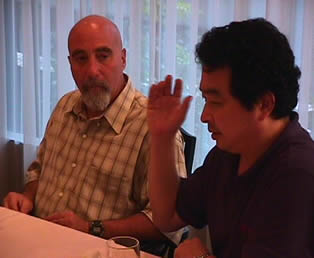 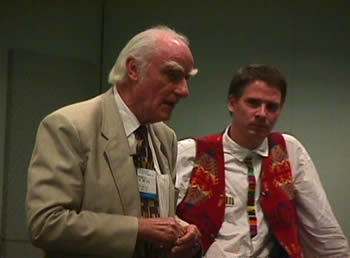
Stuart Hameroff and Kunio Yasue The late Francis Crick and Christof Koch
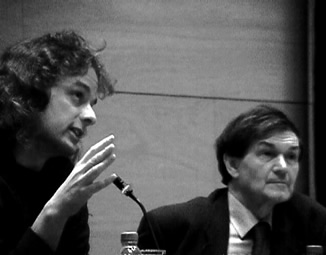 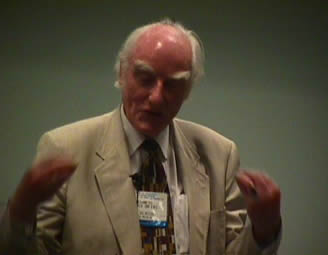
Dave Chalmers and Sir Roger Penrose Francis Crick
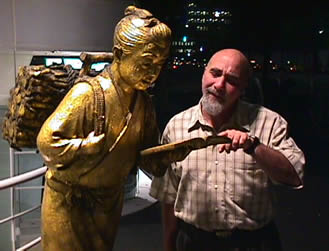 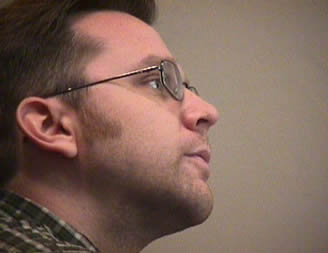
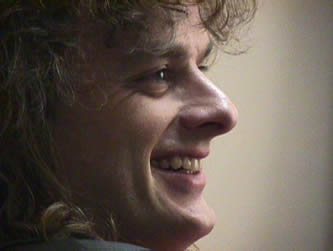 
BACK IN THE DAVE
DAVID CHALMERS on Consciousness
https://www.youtube.com/watch?v=a0M1fLbFp_w#t=16

ALWYN SCOTT
Co-Founder CCS
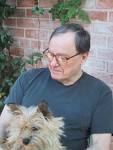
Alwyn C. Scott 1931-2006
Pioneer and champion of nonlinear science
Alwyn C. Scott, an emeritus mathematics professor at the University of Arizona, who helped pioneer the understanding of nonlinear waves, emergent mental patterns and human consciousness, died Jan. 11 of lung cancer. He was 75.
Starting at the University of Wisconsin in the early 1960s, and working in laboratories around the world, Professor Scott made important discoveries in nonlinear science, an emerging field that seeks to understand systems in which the whole is greater or less than the sum of the parts. In particular his work pioneered the application of nonlinear methods to biological molecules like proteins and DNA.
Professor Scott authored six books and edited many others, including the recently
published Encyclopedia of Nonlinear Science, the first volume tocombine wide-ranging research in all of the many fields where nonlinear science is being applied.
In 1980, Professor Scott was a Founding Editor of Elsevier’s Nonlinear Phenomena, the first scientific journal devoted exclusively to this new area. In 1981, he was selected as the Founding Director of the Center for Nonlinear Studies at the Los Alamos National Laboratory. Both the journal and the center were soon copied by other groups around the world.
His research, which stemmed from a boyhood interest in water waves and Ham radio, led him eventually to study the ways impulses move on nerves, how the brain works and how the firing of synapses may give rise to consciousness.
As a doctoral candidate at the Massachusetts Institute of Technology in his 20s, Professor Scott began to explore the behavior of nerve impulses and shock waves. He derived mathematical equations to describe and predict the behavior of such systems that became widely used. He was awarded numerous patents and published more than 150 peer-reviewed articles. Despite the complexity of his work, he often used the example of a simple candle flame to explain how nonlinear equations and methods might be useful in answering questions in many fields.
He frequently described nonlinear science as a “metascience” that can inform other branches of inquiry by allowing researchers to recognize and make calculations about chaotic systems and those in which new structures emerge.
“He’s one of the pioneers in nonlinear science,” said David McLaughlin, provost of New York University and a colleague who wrote a seminal paper with Scott in 1978.
“Most scientists work on one thing in great depth,” he added. “Al worked on a great many things but with depth at the same time -- from low- temperature devices in electrical engineering, to nerve axons, to protein dynamics to the dangers of high-voltage electric wires, to consciousness.”
His work in nonlinear waves showed an unusual breadth of vision, ranging from experiments and the theory of nerve pulses, to energy- conserving waves (solitons) in electronic devices and macro-molecules. These various types of waves conceptually play the role of "elementary particles" in a range of physical and biological phenomena.
“In a way, a nerve impulse can be viewed as an elementary particle of thought, just as an electron is viewed as an elementary particle of matter,” Scott said shortly before he died.
Alwyn Charles Scott was born in Worcester, Mass., on Dec. 25, 1931, coincidentally the date of the first live radio broadcast of the New York Metropolitan Opera, a series in which he later took a lifelong interest. He grew up in Westborough, a town outside Boston, and entered MIT as an undergraduate at age 16. He is survived by his wife of 24 years (May 1982), Lynne MacNeil; their daughter, Lela Scott MacNeil, of New York City; two sons, Emmon Scott of Bloomfield Hills, Mich., and Alwyn Charles Scott Jr. of Seattle, Wash.; and four grandchildren. His previous marriage, to Pauline Feduchka, ended in divorce.
Mr. Scott graduated from the Massachusetts Institute of Technology in 1952 with a degree in physics, and then worked for a variety of institutions, including the physics research laboratory of Sylvania Electric, the U.S. Dept. of Defense and Bell Laboratories. He received a doctorate in electrical engineering from MIT in 1961.
His early work set the direction for a career that revealed the prevalence of nonlinear phenomena in many physical and biological systems. In 1965-66, at the Institute of Applied Physics of the University of Bern, Switzerland, he discovered that the dynamics of magnetic flux propagation on Josephson (superconducting) transmission lines (JTLs) are described by the sine-Gordon
equation. This discovery deeply influenced his research and laid the groundwork for advances in nonlinear science.
He spent much of the 1970s at the Laboratorio di Cibernetica near Naples, Italy, studying the SG equation and fabricating long Josephson junctions. In 1978 he cowrote, with McLaughlin, a widely cited paper on the application of
soliton theory to analyze magnetic flux dynamics on long JTLs, which are modeled by a perturbed SG equation. During the 1979-80 academic year, with support from a European Molecular Biology Organization Fellowship, he worked
at the Stazione Zoologica in Naples, studying the interactions of nerve
impulses near branching regions of squid giant axons.
“To me and many other scientists I believe - among them his many students -
it is one of the miracles in our scientific life that we have met Alwyn
Scott,” said Peter L. Christiansen, emeritus professor of physics at the
Technical University of Denmark. “Without what he taught us and without his
support and encouragement we would not have been what we are.”
Professor Scott was noted for his encompassing mind and a wry sense of humor
drawn from his sometimes contrarian approach to life. When considering an
issue, he often looked humorously to see if the reverse was true, and
enjoyed such games as teasing his family with “opposite day” in which all
statements were assumed to imply their converse.
“He was always open to ideas, and especially to new ideas,” said Alan
Newell, professor of mathematics at the University of Arizona.
His questioning attitude served him in the 1970s in opposing the U.S. Navy’s
plans to build a massive underground antenna in Wisconsin. He testified in
Congress that the system, known as Project Sanguine, not only wouldn’t work
but would harm plant and animal life in the northern half of the state.
In 1985, shortly after moving to Tucson, Ariz., Professor Scott was
tragically struck by a truck while riding a bicycle on his way to campus,
and suffered a broken back that left him paraplegic. He described this event
in a short memoir entitled “The Butterfly Effect,” which poignantly explored
the relationship between nonlinearity and everyday life.
Although his mobility was severely restricted, he continued to teach,
lecture at international conferences and conduct research in both the United
States and Denmark, where he took a permanent joint appointment at the
Technical University in the summer of 1986, working half the year in each
country.
“He was such a vital person,” said Leon Shohet, a professor at the
University of Wisconsin. “When you talked with him you felt that he
concentrated on every word you said.”
After the accident, he traveled less. “But he was still the same Al -- still
looking at the depth of understanding that was so needed to advance fields
of human knowledge,” Shohet said. “This spirit never left him and those with
whom he came in contact with --and those were often people whom he never met
in person because of his difficulties with travel. Whenever we couldn't
understand a concept clearly, I or the students would email Al and the
answer would be forthcoming within 24 hours.
He retired from the University of Arizona in 2000 and from the Technical
University of Denmark in 2001, and resided permanently in Tucson since 2003.
He enjoyed playing the recorder, writing poetry and cooking. “I really liked
to go hiking before I became handicapped,” he said.
Since retirement, he has authored two books, Neuroscience, a Mathematical
Primer (2002); and Nonlinear Science, Emergence and Dynamics of Coherent
Structures (2003).
He also edited the 1053-page Encylopedia of Nonlinear Science (2005), which
contains hundreds of entries covering the whole range of the field. “Alwyn
nursed this project through several difficult years and a change in
publisher, single-handedly re-writing many entries in his own natural and
very readable style,” said Chris Eilbeck, professor at Heriot-Watt
University in Edinburgh, Scotland.
He was completing a final book, The Nonlinear Universe: Chaos, Emergence,
Life, when he was diagnosed with lung cancer in November 2006. It is
scheduled to be published in the spring of 2007.
By Alwyn Scott, Jr.
http://www.tucsonweekly.com/tucson/quantum-consciousness/Content?oid=1066139

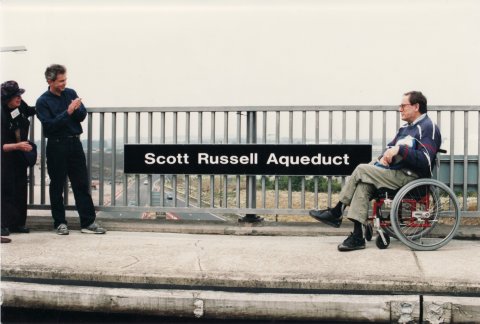
|






